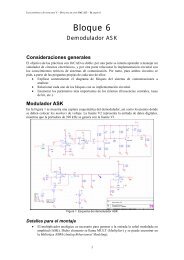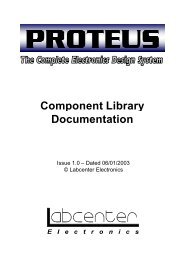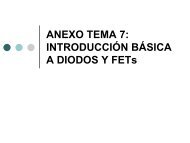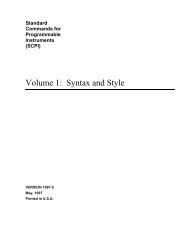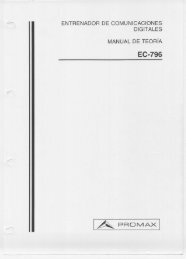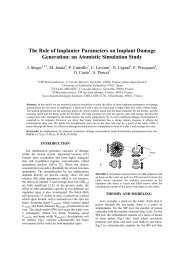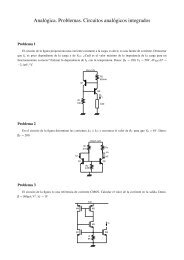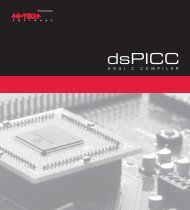You also want an ePaper? Increase the reach of your titles
YUMPU automatically turns print PDFs into web optimized ePapers that Google loves.
Kinetic Monte Carlo Simulation:an Accurate Bridge BetweenAb-Initio Calculations andStandard Process ExperimentalDataM. Jaraíz, P. Castrillo, L. Pelaz,L. Bailon, J. BarbollaUniversity of Valladolid, SpainG.H. Gilmer and C.S. RaffertyLucent Technologies, Bell Labs, USA
The Kinetic Monte Carlo approachVI• Simulate only defects (Point & Extended)• Use ab-initio or classical MD (off-line) to get thenecessary parameters (migration energies, binding, …)• Use BCA to generate each cascade (I,V coordinates)• Anneal using kinetic Monte Carlo (kMC)
Atomistic SimulationofDiffusion and ClusteringSIMULATION SCHEME
SIMULATION BOXFRONT SURFACELATERALBOUNDARYCONDITIONS:•PERIODIC•MIRRORVIBACK SURFACE
SIMULATION SCHEMEDEFECT TYPES1. POINT DEFECTS• SINGLE POINT DEFECTS: V, I, B, C, ...– POSSIBLE EVENT: JUMPJrate = 6 * D o * exp ( -Ea / kT) / L 2• PAIR POINT DEFECTS: IB, Bi, VO, ...– POSSIBLE EVENTS:• JUMP:• BREAK UP:• SWITCH:IB → I + BIB → BiINTERACTION BETWEEN DEFECTS:– CAPTURE RADIUS = 3.84 Å– WITH / WITHOUT AN INTERACTION BARRIER
SIMULATION SCHEMEDEFECT TYPES2. CLUSTERS {311}’s• SHAPES:– IRREGULAR (blob): V, B, C, ...– SPECIFIC:• VOIDS• {311}’s• DISLOCATION LOOPS• STACKING FAULTS• POSSIBLE EVENTS:– CAPTURE of a point defect– EMISSION of a point defect
DEFECT TYPES3. COMPLEXESCOMPOSITION:BINARY: I n B m , I n C m , V n O m , ...TERNARY, ...SHAPE:IRREGULAR (small sizes)SIMULATION SCHEMEPOSSIBLE EVENTS:CAPTURE or EMISSION of a point defect (SINGLE or PAIR)IBiI
DEFECT TYPES4. SURFACESSIMULATION SCHEMEFREE SURFACE (Front):THERMAL I-V GENERATIONNeutral, Oxidation (I),Nitridation (V)SINK for point defects:from perfect SINKto perfect MIRROR (energy barrier)BULK (Back surface):DELAYING SURFACE:Random walkBulk TrapsRe-emission from TrapsTrapTrap
SIMULATION SCHEDULEREXAMPLE: n J rateTotal(jumps/s) Jumps/sV 2 1000 2000I 5 10 50• To simulate 1 second anneal we need to simulate2050 Jumps ⇒ ∆t = 1/2050 seconds per Jump• We have to pick up V’s and I’s with a probability of2000/2050 and 50/2050, respectively.
DIFFUSION SIMULATORSOLVE:CONTINUUMdI/dt = D d 2 I/dx 2 -R BulkTO SIMULATE:I + V ↔ 0ATOMISTICPROGRAM:annihilate(I);annihilate(V);TO ADD NEW MECHANISM:I + B s ↔ BSOLVE:IPROGRAM:dI/dt = D d 2 I/dx 2 -K IF B s I + K IR B I -R Bulkannihilate(I);d B I /dt = D dB 2 I /dx 2 + K BIF B s I - K BIR BBII annihilate(B S );create(Bd B S /dt = - K BSF B s I + K BSR B I );I⇒ ALMOST NO ADDITIONAL COMPUTATION TIME
SIMULATION EXAMPLES
AT THE UNIVERSITY OF VALLADOLID WE HAVEIMPLEMENTED A FAST ATOMISTIC SIMULATOR :DADOS(Diffusion of Atomistic Defects, Object-oriented <strong>Simulator</strong>)PERFORMANCE: 1.4 seconds / Million events(450 MHz Pentium II Xeon, Microsoft Visual C++ compiler)On average, simulates one event in the time it takes tocalculate three Jump rates:Jrate = 6 * D o * exp ( -Ea / kT) / l 2
Anomalous Boron Diffusionin Silicon Processing
Anomalous Boron Diffusion in Silicon Processing:Experimental data (SIMS) and Kinetic Monte CarlosimulationAppl. Phys. Lett. 70, 2285 (1997)
Ion Implantation damage in Si:{311} self-interstitials Defects
DADOS simulation40 keV Si implantafter 5 seconds at 800CExperiment (TEM)
DADOS simulation40 keV Si implantafter 30 seconds at 800CExperiment (TEM)
Energetics of {311} Defects
Interstitial Supersaturation vs. Annealing Time1.E+081.E+071.E+06Formation Energy(eV)1.61.41.210.80.60.41 10 100 1000Cluster size1.E+05Experiment 600CExperiment 700C1.E+041.E+031.E+021.E+00 1.E+01 1.E+02 1.E+03 1.E+04 1.E+05 1.E+06Experiment 800CDADOS 600CDADOS 700CDADOS 800CCowern et al, Phys. Rev. Lett., in press
Dopant Fluctuations
Discreteness of Channel Dopants =>Average Shift ofThreshold VoltageH.S Wong and Y. Taur, IEDM 93 A. Asenov, IEDM 98
=> Do the local inhomogeneitiesdue to clusters induce a spatialcorrelation in the dopant atoms?Comparison between same dopantdepth distributions generated:•Randomly•With the actual ion cascades
Radial Distribution FunctionBlue: RandomRed: Cascades=> The diffusion process fullyrandomizes any localinhomogeneities due to clusters
However, diffusion of charged pointdefects could still give rise to spacecorrelation (local fluctuations).In fact, similar effects have beenshown to occur in the oxide chargedistribution in MOS structures => increasein the effective mobility.F. Gamiz et al., Semic. Sci. And Technol. 9, 1102-1107 (1994)
0.12 µm MOSFET
TEM micrograph: F. Baumann
KINETIC LATTICE MONTECARLO SIMULATION OFPOLYCRYSTALLINETHIN-FILM DEPOSITION
INTRODUCTIONAluminum:Polycrystalline structure0.5 µm100 nm* Y-S Kang et al, J. Electron. Mater. 26, 805 (1997)* S.P. Murarka, “Metallization”, Butterworth-Heinemann, 1993Microstructure of the deposited films during deposition and annealing:Grain sizes, surface textureIt depends on: temperature, deposition rate, substrate conditions
DEPOSITION!Random initial position on the top of the simulation boxRandom velocity angles according to the desired angle distribution.! Atom travels in a straight line until either:" It finds some neighbors:it finally get attached to the lower energy sitein the neighborhood" It finds no neighbors: It starts a new orientation.
GRAIN BOUNDARIESJump to the Site which minimizes the energy:Grain growth competitionA1B1A2
SIMULATION RESULTS“Wetting substrate”(Strong bonding)=> smaller grains“Non wetting substrate”(Weak bonding)
Bonding to substrate:effect on the grain size“Wetting substrate”(Strong bonding)=> smaller grains“Non wetting substrate”(Weak bonding)
Channeling Implants:Relevance of theElectron DensityDistribution
Channeling Implants:Relevance of the Electron DensityDistributionZBL(Hartree-Fock)LDALDA, radial
SIMSThis WorkCai et al.,Phys. Rev. B54,17147 (1996)
SIMSLDALDA, radial
Conclusions• Atomistic Process <strong>Simulator</strong>s provide a bridgebetween ab initio calculations and standardprocess experimental data.• Efficient and accurate 3D simulation.• Straighforward implementation of newmechanisms.• Microelectronics Device Processing:“Continuum physics models are no longersufficient below 100 nm. Tools are needed forthe physical and chemical processes at anatomic level” (1997 USA National TechnologyRoadmap for Semiconductors)





